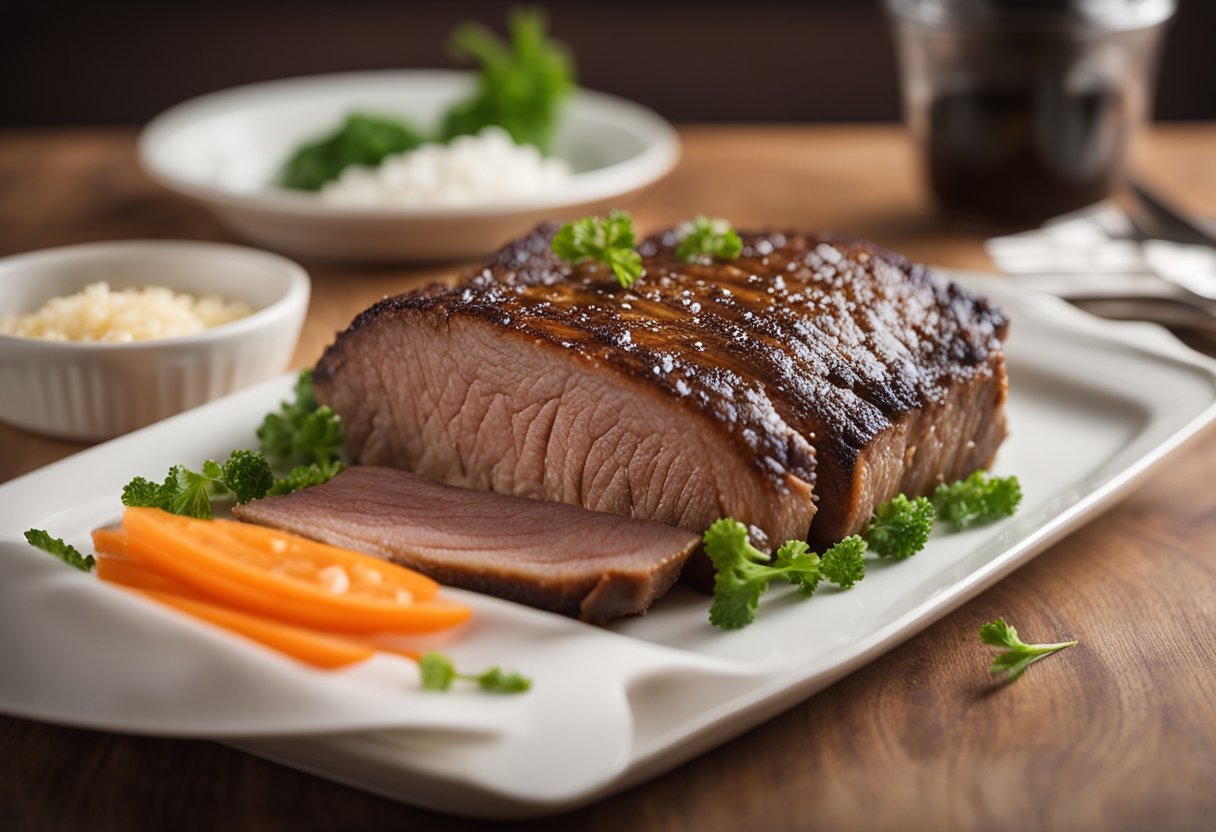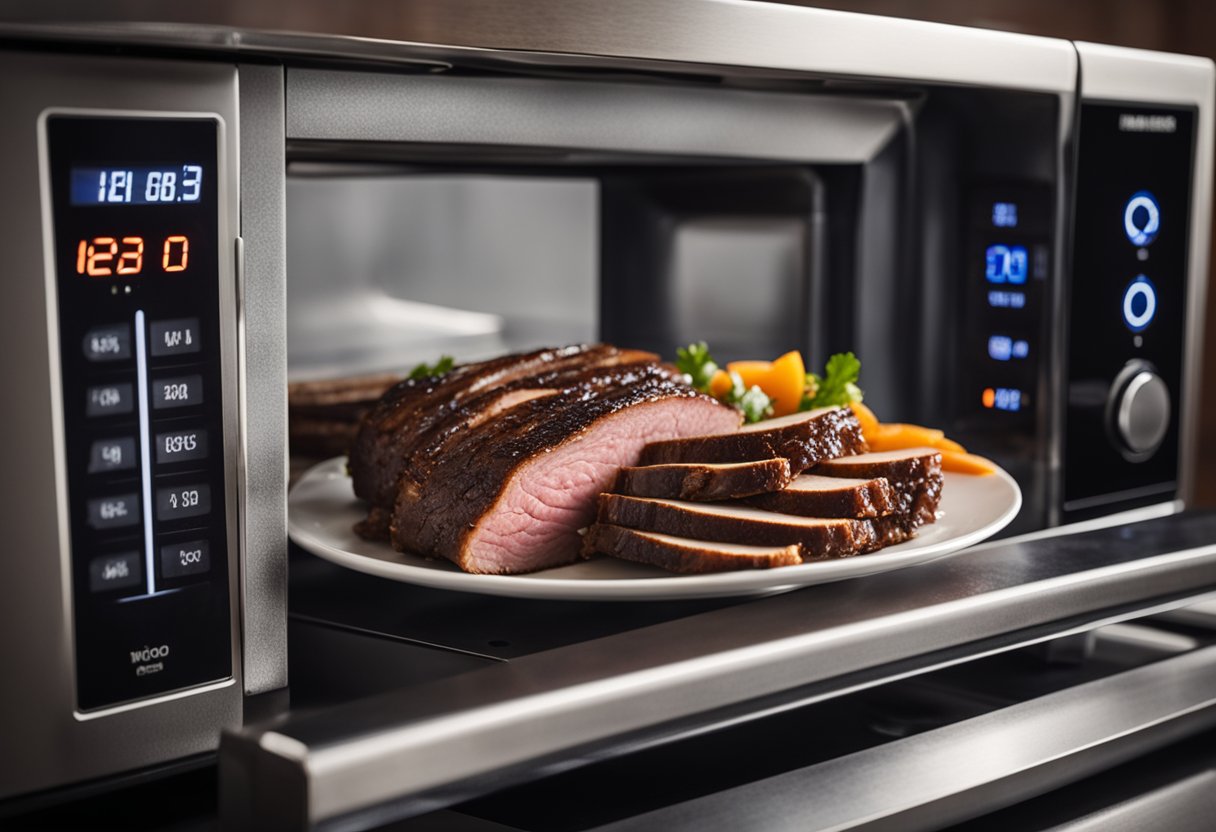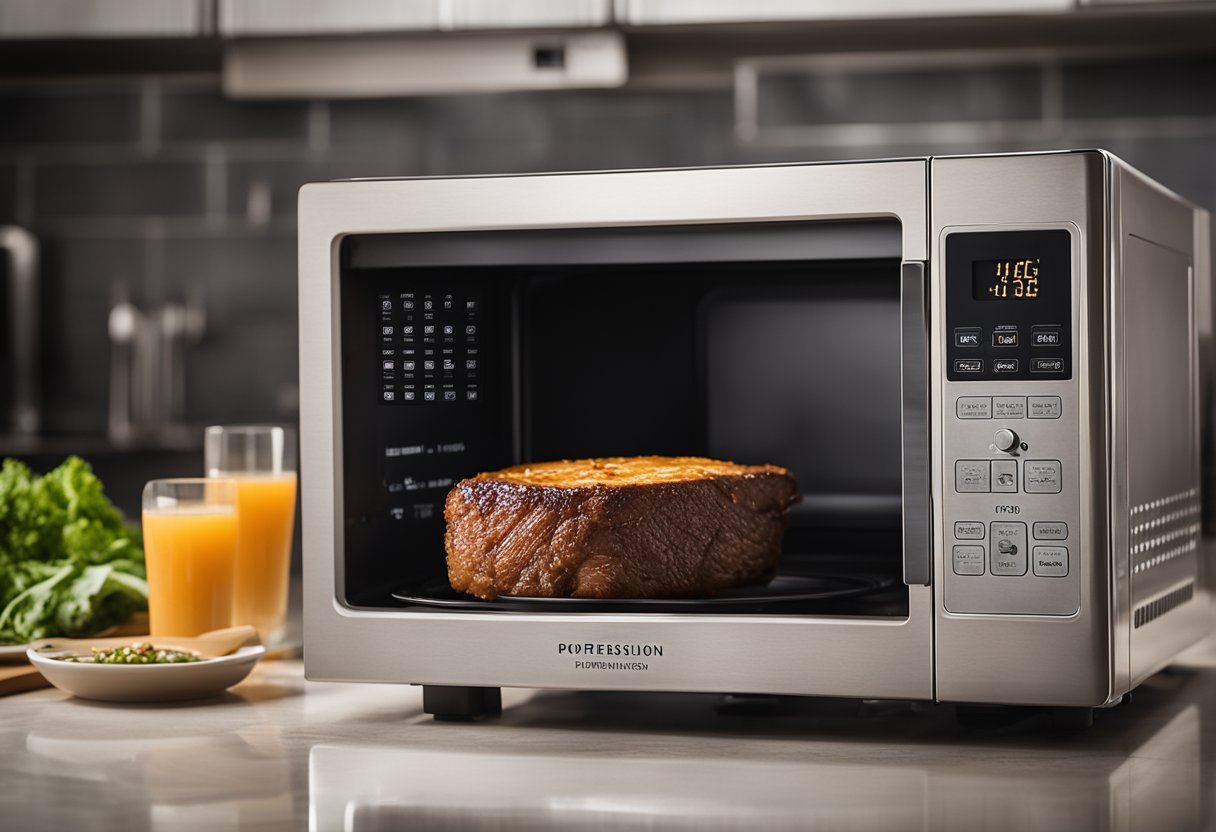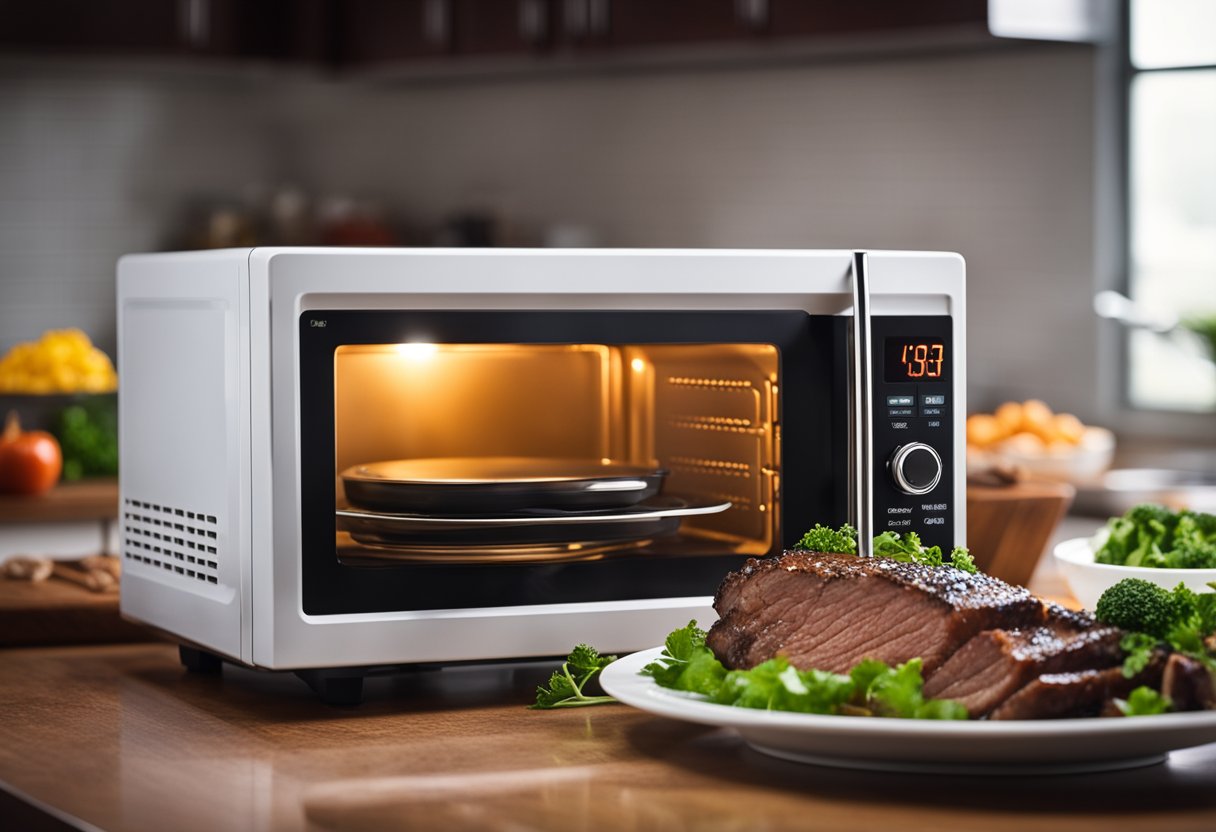Reheating brisket can be a challenge, especially if you want to keep it tender and juicy. While there are several ways to reheat brisket, using the microwave is one of the quickest and easiest methods.
In this article, I will share my tips on how to reheat brisket in the microwave like a pro.

To reheat brisket in the microwave, you need to prepare it properly and use the right technique. This includes slicing the brisket against the grain, wrapping it in a microwave-safe cover, and heating it up in short intervals.
By following these steps, you can ensure that your brisket stays moist and flavorful, without becoming tough or dry.
If you’re looking for a fast and efficient way to reheat leftover brisket, then the microwave is your best bet. With a little bit of know-how, you can turn your cold, hard brisket into a warm and tender meal in no time.
So let’s get started and learn how to reheat brisket in the microwave like a pro.
Key Takeaways
- Proper preparation and slicing is key to reheating brisket in the microwave.
- Covering the brisket and heating it up in short intervals helps to ensure tenderness and flavor.
- While there are alternative reheating methods, the microwave is a quick and easy option for leftover brisket.
Preparing Brisket for Reheating

When it comes to reheating brisket in the microwave, there are a few important steps to follow to ensure that the meat stays tender and moist.
In this section, I will take you through the process of preparing your brisket for reheating.
Thawing the Brisket
If you have leftover brisket that you want to reheat, the first step is to thaw it properly. You can thaw your brisket by placing it in the refrigerator overnight.
If you are in a hurry, you can also thaw it in the microwave using the defrost setting. Be sure to remove any plastic wrap or packaging before thawing the brisket in the microwave.
Prepping the Microwave
Before reheating your brisket in the microwave, you need to make sure that your microwave is clean and free of any food debris. This will help to prevent any unwanted flavors from contaminating your meat.
Next, you should place your sliced brisket in a microwave-safe dish and cover it with a damp paper towel or microwave-safe lid. This will help to trap in the moisture and prevent the meat from drying out.
If you have any leftover juices from cooking your brisket, you can pour them over the meat before reheating. This will help to keep the meat tender and moist.
It is important to note that reheating brisket in the microwave can be a bit tricky. You need to make sure that you are using the correct power level and cooking time to prevent overcooking or undercooking the meat.
By following these simple steps, you can ensure that your reheated brisket stays tender, moist, and delicious.
Microwave Reheating Technique
When it comes to reheating brisket in the microwave, there are a few things to keep in mind to ensure that the meat is heated evenly and doesn’t dry out.
Setting the Temperature
First, it’s important to set the microwave to the appropriate temperature. Setting the microwave to high heat is not recommended as it can cause the brisket to dry out. Instead, set the microwave to medium or medium-high heat to ensure that the brisket is heated evenly without losing its moisture.
Using Moisture to Prevent Dryness
To prevent the brisket from drying out during the reheating process, it’s important to use moisture. One way to do this is to wrap the brisket in a damp paper towel or cloth before placing it in a microwave-safe container.
Another option is to place a small amount of beef broth or water in the container with the brisket to help keep it moist.
It’s also recommended to cover the container with a microwave-safe lid or plastic wrap to help trap in the moisture. However, be sure to leave a small vent in the cover to allow steam to escape and prevent the cover from exploding.
In addition, it’s important to check the internal temperature of the brisket during the reheating process to ensure that it has reached a safe temperature of 165°F (74°C). This can be done using a meat thermometer.
When reheating leftovers, it’s best to use a ceramic container as it helps to distribute heat evenly. If the brisket is frozen, it’s recommended to thaw it in the refrigerator overnight before reheating.
Overall, reheating brisket in the microwave can be a quick and easy way to enjoy leftover meat. By following these tips, you can ensure that your brisket is heated evenly and stays moist.
Ensuring Brisket Tenderness and Flavor

When reheating brisket in the microwave, it’s important to take certain steps to ensure that the meat remains tender and flavorful.
Here are some tips to help you achieve the best results possible.
Checking for Doneness
Before reheating your brisket in the microwave, it’s important to check for doneness. Make sure that the meat is fully cooked and that there are no pink spots in the center. If the brisket is not fully cooked, it may become tough and chewy when reheated.
To check for doneness, insert a meat thermometer into the thickest part of the brisket. The internal temperature should be at least 165°F (74°C). If the temperature is lower than this, continue cooking the brisket until it reaches the correct temperature.
Adding Flavor Enhancers
When reheating brisket in the microwave, it’s important to add flavor enhancers to keep the meat from becoming dry and bland.
Here are some suggestions for adding flavor to your reheated brisket:
- Barbecue sauce: Brush some barbecue sauce onto the brisket before reheating it in the microwave. This will help keep the meat moist and add a delicious smoky flavor.
- Au jus: Serve the reheated brisket with a side of au jus for dipping. This will add moisture and flavor to the meat.
- Stock: Add some beef stock or apple cider to the dish before reheating the brisket. This will help keep the meat moist and add a delicious flavor to the dish.
By following these tips, you can ensure that your reheated brisket is tender, juicy, and delicious.
Alternative Reheating Methods

If you don’t have a microwave or you want to explore other options, there are several alternative methods to reheat brisket.
Here are a few:
Oven Reheating
The oven method is a popular and effective way to reheat brisket. Preheat your oven to 325°F (162°C) and place the brisket in a baking pan. Cover it with aluminum foil to keep the moisture in.
Place the pan in the oven and bake for about 20 minutes or until the brisket is heated through. This method is great for ensuring that your brisket does not dry out.
Sous Vide Reheating
Sous vide is a French technique that involves cooking food in an airtight bag in a water bath at a precise temperature. It’s also a great way to reheat brisket without drying it out.
To use this method, place your brisket in an airtight bag and use a sous vide machine to heat the water to 150°F (65°C). Place the bag in the water and let it heat for about 45 minutes to an hour. Once heated, remove the brisket from the bag and serve.
Grill Reheating
Grilling is another great way to reheat brisket. Preheat your grill to medium heat and place the brisket on the grill. Cover it with aluminum foil to keep the moisture in.
Grill for about 10 minutes or until the brisket is heated through. This method is great for adding a smoky flavor to your brisket.
No matter which method you choose, make sure to keep an eye on your brisket to ensure that it does not dry out. Also, be sure to use an airtight bag or cover to keep the moisture in.
With the right technique, you can achieve a perfect reheated brisket every time.
Storing Leftover Brisket

As a meat lover, I always make sure to store my leftover brisket properly to maintain its quality and freshness.
In this section, I will share with you some best practices for storing leftover brisket.
Refrigeration Best Practices
Refrigeration is the most common way of storing leftover brisket. To ensure your brisket stays fresh, store it in an airtight container or wrap it tightly in plastic wrap or aluminum foil.
This will prevent the meat from being exposed to air, which can cause dehydration and freezer burn. You can also use a vacuum sealer or food saver bag to remove oxygen and ensure freshness.
When refrigerating leftover brisket, it is important to keep it at a temperature of 40°F or below. This will prevent bacteria from growing and keep the meat from spoiling. You can store leftover brisket in the refrigerator for up to 4 days.
Freezing and Vacuum Sealing
If you have more leftover brisket than you can eat within 4 days, consider freezing it. Freezing is a great way to extend the shelf life of your brisket and prevent it from going to waste.
To freeze leftover brisket, wrap it tightly in plastic wrap or aluminum foil, or vacuum pack it using a vacuum sealer or food saver bag. Make sure to remove as much air as possible to prevent freezer burn and dehydration.
When freezing leftover brisket, it is important to label it with the date and contents. This will help you keep track of how long the brisket has been frozen and prevent confusion with other frozen meats.
When you’re ready to use your frozen brisket, thaw it in the refrigerator overnight. Thawing in the refrigerator is the safest method, as it prevents the brisket from being exposed to temperatures that can cause bacterial growth.
By following these best practices, you can ensure that your leftover brisket stays fresh and delicious for longer.
Frequently Asked Questions

What is the optimal temperature for reheating brisket in the microwave?
The optimal temperature for reheating brisket in the microwave is 165°F. This is the temperature that ensures that the brisket is heated thoroughly and is safe to eat. It is important to use a food thermometer to check the internal temperature of the brisket.
How can I retain moisture when reheating brisket in the microwave?
Retaining moisture when reheating brisket in the microwave is essential to prevent the meat from drying out. To retain moisture, you can add a small amount of liquid, such as beef broth or barbecue sauce, to the brisket before reheating it.
You can also cover the brisket with a damp paper towel or a microwave-safe lid to trap the moisture.
What are the time recommendations for reheating brisket in the microwave?
The time recommendations for reheating brisket in the microwave depend on the amount and thickness of the brisket. As a general rule, you should reheat brisket in the microwave for 1-2 minutes per 4 ounces of meat.
However, it is important to check the internal temperature of the brisket with a food thermometer to ensure it reaches 165°F.
Are there any special techniques for reheating brisket in the microwave without drying it out?
Yes, there are special techniques for reheating brisket in the microwave without drying it out. One technique is to slice the brisket into thin pieces and arrange them in a single layer on a microwave-safe plate.
Cover the plate with a damp paper towel or a microwave-safe lid and microwave on high for 30 seconds to 1 minute. Check the internal temperature of the brisket with a food thermometer to ensure it reaches 165°F.
Can I use a microwave to reheat brisket slices, and how does it differ from reheating a whole brisket?
Yes, you can use a microwave to reheat brisket slices. Reheating brisket slices in the microwave differs from reheating a whole brisket because it takes less time and requires less liquid to retain moisture.
To reheat brisket slices, arrange them in a single layer on a microwave-safe plate, cover the plate with a damp paper towel or a microwave-safe lid, and microwave on high for 30 seconds to 1 minute.
Is it necessary to cover brisket when reheating it in the microwave, and if so, what should I use?
Yes, it is necessary to cover brisket when reheating it in the microwave to retain moisture and prevent the meat from drying out.
You can use a damp paper towel or a microwave-safe lid to cover the brisket. Be sure to leave a small vent to allow steam to escape.
